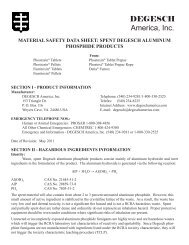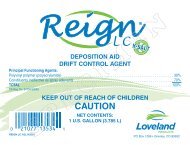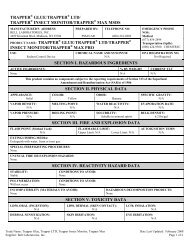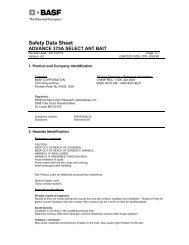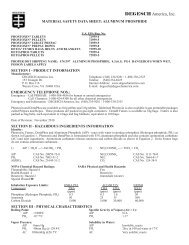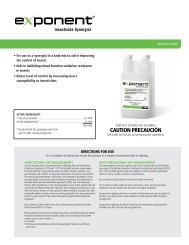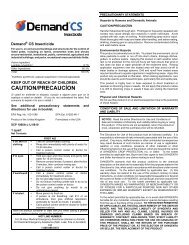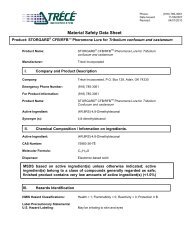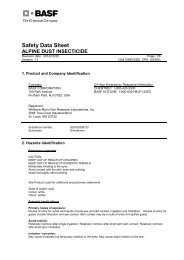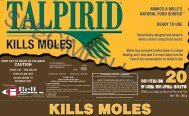Fluorescent Blacklight Lamps - Osram Sylvania
Fluorescent Blacklight Lamps - Osram Sylvania
Fluorescent Blacklight Lamps - Osram Sylvania
Create successful ePaper yourself
Turn your PDF publications into a flip-book with our unique Google optimized e-Paper software.
PRODUCT SAFETY DATA SHEETPSDS No. 1.1.4FLUORESCENT BLACKLIGHT LAMPSSYLVANIA brand <strong>Fluorescent</strong> <strong>Lamps</strong>, manufactured by OSRAM SYLVANIA, are exempted from the requirements ofthe OSHA Hazard Communication Standard (29 CFR 1910.1200) because they are “articles.” The following informationis provided by OSRAM SYLVANIA as a courtesy to its customers.-----------------------------------------------------------------------------------------------------------------------------------------------------------I. PRODUCT IDENTIFICATION-----------------------------------------------------------------------------------------------------------------------------------------------------------Trade Name (as labeled): <strong>Sylvania</strong> "350BL" <strong>Blacklight</strong> <strong>Fluorescent</strong> <strong>Lamps</strong>Manufacturer:OSRAM SYLVANIA100 Endicott StreetDanvers, MA 01923(978) 777-1900-----------------------------------------------------------------------------------------------------------------------------------------------------------II. HAZARDOUS INGREDIENTS-----------------------------------------------------------------------------------------------------------------------------------------------------------THERE ARE NO KNOWN HEALTH HAZARDS FROM EXPOSURE TO LAMPS THAT AREINTACT. If the lamp is broken, the following materials may be released:Chemical Name CAS Number % by wt. Exposure Limits in Air (mg/cubic m)ACGIH (TLV) OSHA (PEL)Glass (Soda-Lime) --- 80-90 10.0 (2) 15.0 (2)(1,4) Mercury 7439-97-6
Product Safety Data Sheet for <strong>Sylvania</strong> Brand <strong>Fluorescent</strong> “350BL” <strong>Blacklight</strong> <strong>Lamps</strong> PSDS No. 1.1.4-----------------------------------------------------------------------------------------------------------------------------------------------------------V. HEALTH HAZARDS-----------------------------------------------------------------------------------------------------------------------------------------------------------A. OPERATING LAMPSConsult the OSRAM SYLVANIA Product Catalog or relevant technical data sheets for complete warnings,operating and installation guides for specific lamp types.WARNING: This lamp emits ultraviolet (UV) power during operation. See lamp carton for exposureinformation. Certain medications and chemicals can increase an individual’s sensitivity to UV.Consult your physician for specific information. Protective eyewear should be worn inoccupational situations involving long-term exposure in close proximity to the lamps. Lampmodel “F6T5/350BL” is RG-1, all other “350BL” models are RG-2 per ANSI/IESNA RP-27.3-96.B. LAMP MATERIALSTHERE ARE NO KNOWN HEALTH HAZARDS FROM EXPOSURE TO LAMPS THATARE INTACT. No adverse effects are expected from occasional exposure to broken lamps. As a matterof good practice, avoid prolonged or frequent exposure to broken lamps unless there is adequateventilation. The major hazard from broken lamps is the possibility of sustaining glass cuts.NIOSH/OSHA Occupational Health Guidelines for Chemical Hazards and/or NIOSH Pocket Guide toChemical Hazards lists the following effects of overexposure to the chemicals/materials tabulatedbelow when they are inhaled, ingested, or contacted with skin or eye:Mercury - Exposure to high concentrations of vapors for brief periods can cause acute symptoms such aspneumonitis, chest pains, shortness of breath, coughing, gingivitis, salivation and possibly stomatitis. Maycause redness and irritation as a result of contact with skin and/or eyes.Lead - Ingestion and inhalation of lead dust or fume must be avoided. Irritation of the eyes and respiratorytract may occur. Excessive lead absorption is toxic and may include symptoms such as anemia, weakness,abdominal pain, and kidney disease. However, the chemical inertness and insolubility of this material isexpected to reduce the potential for systemic lead toxicity.Glass - Glass dust is considered to be physiologically inert and as such, has an OSHA exposure limit of 15mg/cubic meter for total dust and 5 mg/cubic meter for respirable dust. The ACGIH TLVs for particulatesnot otherwise classified are 10 mg/cubic meter for total dust and 3 mg/cubic meter for respirable dust.Phosphor - Inhalation of insoluble barium compounds has been reported to cause benign pneumoconiosiswith no specific symptoms and no changes in pulmonary function.EMERGENCY AND FIRST AID PROCEDURES:Glass Cuts: Perform normal first aid procedures. Seek medical attention as required.Inhalation: If discomfort, irritation or symptoms of pulmonary involvement develop, remove from exposure andseek medical attention.Ingestion: In the unlikely event of ingestion of a large quantity of material, seek medical attention.Contact, Skin: Thoroughly wash affected area with mild soap or detergent and water and prevent further contact.Seek medical attention if irritation occurs.Contact, Eye: Wash eyes, including under eyelids, immediately with copious amounts of water for 15 minutes.Seek medical attention.CARCINOGENIC ASSESSMENT (NTP ANNUAL REPORT, IARC MONOGRAPHS, OTHER): None-----------------------------------------------------------------------------------------------------------------------------------------------------------Page 2 of 3 08/16/12
Product Safety Data Sheet for <strong>Sylvania</strong> Brand <strong>Fluorescent</strong> “350BL” <strong>Blacklight</strong> <strong>Lamps</strong> PSDS No. 1.1.4-----------------------------------------------------------------------------------------------------------------------------------------------------------VI. REACTIVITY DATA-----------------------------------------------------------------------------------------------------------------------------------------------------------Stability: StableConditions to avoid: None for intact lamps.Incompatibility (materials to avoid): None for intact lamps.Hazardous decomposition products (including combustion products): None for intact lampsHazardous polymerization products: Will not occur.-----------------------------------------------------------------------------------------------------------------------------------------------------------VII. PROCEDURES FOR DISPOSAL OF BROKEN LAMPS-----------------------------------------------------------------------------------------------------------------------------------------------------------OSRAM SYLVANIA recommends that all mercury-containing lamps be recycled. For a list of lamp recyclersand to obtain state regulatory disposal information, log onto www.lamprecycle.org.Ventilate area where breakage occurred. Clean-up with a special mercury vacuum cleaner (not a standardvacuum cleaner) or other suitable means that avoid dust and mercury vapor generation. Take usual precautionsfor collection of broken glass. Clean-up requires special care due to mercury droplet proliferation. Placematerials in closed containers to avoid generating dust.It is the responsibility of the waste generator to ensure proper classification and disposal of waste products. Tothat end, TCLP tests should be conducted on all waste products, including this one, to determine the ultimatedisposition in accordance with applicable federal, state and local regulations. Some states have specific disposalrequirements for lamps containing mercury.-----------------------------------------------------------------------------------------------------------------------------------------------------------VIII. SPECIAL HANDLING INFORMATION - FOR BROKEN LAMPS-----------------------------------------------------------------------------------------------------------------------------------------------------------Ventilation: Use adequate general and local exhaust ventilation to maintain exposure levels below the PEL orTLV limits. If such ventilation is unavailable, use respirators as specified below.Respiratory Protection: Use appropriate NIOSH approved respirator if airborne dust concentrations exceed thepertinent PEL or TLV limits. All appropriate requirements set forth in 29 CFR 1910.134 should be met.Eye Protection: OSHA specified safety glasses, goggles or face shield are recommended if lamps are beingbroken.Protective Clothing: OSHA specified cut and puncture-resistant gloves are recommended for dealing withbroken lamps.Hygienic Practices: After handling broken lamps, wash thoroughly before eating, smoking or handling tobaccoproducts, applying cosmetics, or using toilet facilities.Although OSRAM SYLVANIA Products Inc. attempts to provide current and accurate information herein, itmakes no representations regarding the accuracy or completeness of the information and assumes no liability forany loss, damage or injury of any kind which may result from, or arise out of, the use of, or reliance on theinformation by any person.-----------------------------------------------------------------------------------------------------------------------------------------------------------Issue Date: August 16, 2012 Rev DSupercedes: July 19, 2011 Rev C-----------------------------------------------------------------------------------------------------------------------------------------------------------In case of questions, please call:OSRAM SYLVANIAProduct Safety Engineer(978) 777-1900Page 3 of 3 08/16/12



